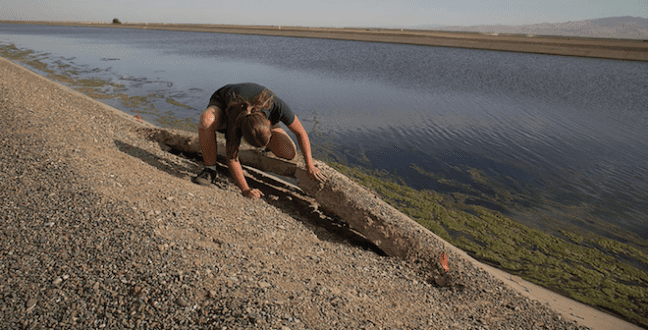

Oct 4, 2021Water woes challenge Western ag
In September, when funding was gutted for a much-anticipated water bill, then withdrawn from the floor of the California state legislature, growers responded with fighting words.
Senate Bill 559, also known as the State Water Resiliency Act of 2021, would have provided $785 million to fix the Friant-Kern Canal, the Delta-Mendota Canal and major portions of the California Aqueduct, all of which have degraded and are losing water as a result of subsidence, or the actual shrinking of land. Millions of acres bearing hundreds of different crops are irrigated via that infrastructure.


A season of drought, coupled with inaction at the state legislature and ongoing worries about groundwater have growers concerned this season.
Drought decisions
Drought conditions in the West are among the driest they’ve been in recorded history.


“We are dry. We are drier than we’ve ever been. That is an issue that we really can’t point the blame at anybody for,” LeMay said in an interview with Fruit Growers News. “That’s a Mother Nature issue. But that does not remove our responsibility for when it does rain or does snow. Hopefully, October 1 – that’s the start of our water year, so hopefully late October, early November we start getting precipitation and snowfall in our Sierras, because we need that.”
The news website Axios.com earlier this year reported that, according to a UCLA geographer, soil moisture across the West during March was the lowest it has been in at least 120 years.
A mid-September report by the U.S. Drought Monitor said the West’s situation remained very dire:
“According to the (USDA), topsoil moisture was rated 100% very short to short on Sept.12 in Washington (state), followed by 96% in Montana, 85% in California, 83% in Oregon, 79% in Wyoming, and 73% in Idaho. Meanwhile, USDA reported that at least one-half of the acreage devote to rangeland and pastures was rated in very poor to poor condition in eight of the 11 Western states, led by Washington (96%), Montana (88%) and Oregon (87%). At the end of August, California’s 154 intrastate reservoirs contained 13.8 million acre-feet of water, just 60% of average for the date. Preliminary reports indicated that statewide reservoir holdings were less than one-half of the end-of-August average in Nevada, New Mexico and Oregon. Meanwhile, several dangerous wildfires remained active across northern California and the Northwest.”
LeMay said that although things are dry now, the state needs to repair infrastructure so it can make the most of the wet weather.
“We need to fortify, and in my opinion expand our systems, so that when that rain comes, we can capture it,” he said. “We can efficiently distribute it and maximize it if there is utility in the system, but it doesn’t make sense to have broken elements of our water system a la the pinch point in the Friant-Kern Canal or other degradations in the Delta-Mendota Canal or the California Aqueduct, because that diminishes our opportunity to maximize the utility of available water. … We need to fix our plumbing system where there are breaks in the pipe.”
Legislative letdown


A smaller amount of money earlier in the year – $100 million – had been allocated for canal repairs, according to a news release from Hurtado. But then her own, more substantial, bill wasn’t funded.
“Western states are at war with climate change-driven drought,” Hurtado said in the release. “The situation continues to worsen, and solutions for us to adapt are clear. The cries for help from communities that are running out of water and from struggling farmers wasn’t enough to stop forced Assembly amendments to a sound solution. It is unfortunate, but I will not add further pain to struggling farmworkers and communities. For this reason, I am withholding (Senate Bill) 559 for a vote this session.”
For LeMay, the de-funding was frustrating.
“For some reason, even though we all agree that they need to be fixed, when Senator Hurtado proffered and brought up SB 559 this time … for some reason, when we’re in the worst drought in 120 years of California history of tracking drought, when our reservoirs, when our canals are holistically empty across the state, and when our state, our governor, over the last six months have continually beat their chests that we have a $75 billion-plus surplus, we couldn’t come up with one meaningful dollar to expand on fixing those three convenience systems,” LeMay said.
“I think there are some within the state legislature who would like to see a reduction in California agriculture,” LeMay said. He hesitated to get specific about the political opposition, but said: “it’s a broad net of blame and criticism for our state legislature and our elected officials in Sacramento.”
While the canals and aqueduct serve 3.25 million acres of irrigated land where hundreds of different crops are grown, LeMay added that the projects were designed to benefit much of the state’s population.
“Twenty-three and a half million people in California – over 50% of California’s population – derive some of their drinking water or irrigation water from those three conveyance systems,” he said.
Congressman Jim Costa and U.S. Sen. Dianne Feinstein have companion legislation in Congress. LeMay said the costs could have been split three ways between the federal government, the state and the actual customers of the water service.
“This (bill) isn’t a free ride for a rural community or an agricultural community,” he said.
— Stephen Kloosterman, associate editor; Photo at top: Reduced surface-water availability (associated with droughts) during 1976-77, 1986-92, 2007-09 and 2012-2016 caused groundwater-pumping increases, water-level declines to near or beyond historic lows and renewed aquifer compaction. The resulting land subsidence has caused canal buckling and reduced flow capacity of the Delta-Mendota Canal (pictured), the California Aqueduct, the Eastside Bypass and other structures that transport floodwater or deliver irrigation water. Photo: Claudia Faunt/U.S. Geological Survey














